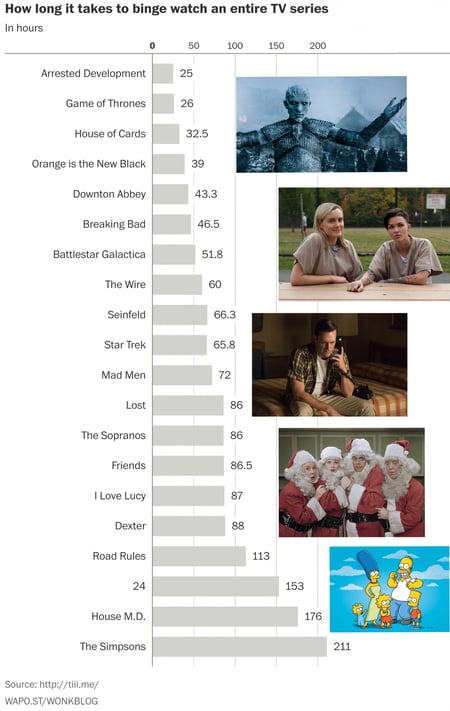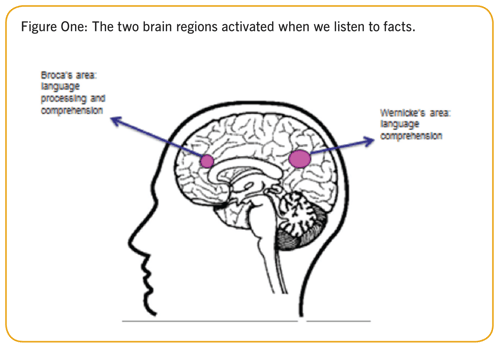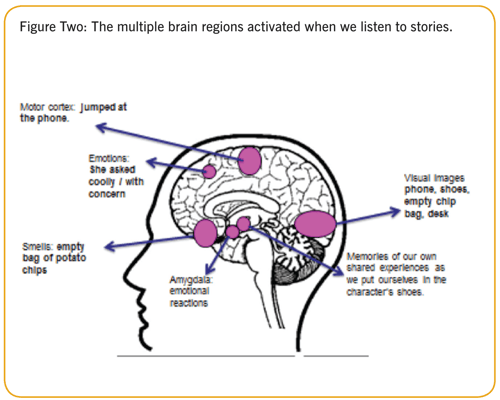Binge-watching TV has become more mainstream than ever, and audiences today expect riveting stories and high-quality visuals.
99% of American homes have at least one TV and the average viewer spends 3½ hours in front of a screen on weekdays, and 4 hours daily on weekends. Today’s online on-demand media services such as Netflix—which allow viewers to watch multiple episodes in a single sitting—have mastered the art of keeping viewers on the couch. In fact, a new Deloitte survey shows that 70% of Americans routinely watch 5 episodes in one sitting. Clearly, television has raised the bar on what it takes to get and hold a viewer’s attention.
When today’s audiences enter your jury box, they expect emotional narratives they can relate to and visuals that captivate their attention.
For the average juror who has grown accustomed to contemporary multimedia entertainment, a bulleted list no longer does the job. It is not enough to make your argument convincing—it must be engaging. Providing today’s jurors with high-quality visual information gives you a strategic advantage in the courtroom.
THE POWER BEHIND A PARADOX
We live in a fast-paced century when most of us complain we have too much to do and too little time. So how does TV manage to hold our attention, keeping us glued to a screen for hours each day? This paradox offers potent secrets that can help you win in court. First, let’s take a closer look at binge-watching to understand TV’s power over viewers. According to one Netflix survey:
- Binge-watching is the new standard.
- The majority of viewers feel binge-watching is a positive part of their lives.
- Most viewers say TV has improved so dramatically that there is too much to watch and not enough time.
- While Twitter, Instagram, and other social media create fragmented communication, viewers have a strong appetite for long, complex narratives.
The Washington Post chart below shows the extent to which viewers are willing to invest a great deal of their time in a program they find engaging:

TODAY'S VIEWER = TODAY'S JUROR
Visual storytelling—think rock art—has been around almost as long as humans have. Yet, the demand for visual information, whether fictional or fact-based, appears greater than ever. And today’s TV viewer is today’s juror. Television caters to millions and enjoys a sizable budget. Litigation, on the other hand, caters to twelve jurors and a judge. While you cannot compare visuals designed for television with those used in courtrooms, arbitrations, and mediations, you can apply the essential concepts that make contemporary TV irresistible.
In the courtroom, a litigator’s job is to tell their clients’ side of a story and make it persuasive. Reading bullet points from slides tends to remind jurors of feeling bored in school—not the effect you want. Let’s talk about how you can engage jurors so they don't get distracted, giving you a strong advantage in the courtroom.
CREATE PRESENTATIONS THAT ENGAGE
Research tells us that a picture is truly worth a thousand words. So why is this cliché a powerful fact?

65% of us are visual learners, and we tend to learn faster and retain more from visual information. This is because our long-term memory easily stores images, and they are transmitted 60,000 times faster than text. Pairing text with a relevant, meaningful image is the way we learn best—and are most likely to understand and recall what we have learned. Visuals elicit emotions, and emotions engage and motivate us.
However, research also tells us that if visual information is too complex or confusing, the mind has a tendency to lose interest.
Based on what we know about the power of imagery, here are two key strategies to keep jurors focused on your argument:
1) Simplify for Compelling Visual CompositionCreating strong visuals takes more than multiple fonts and spinning clip art images. And if not designed well, visuals can make concepts confusing. It is essential to begin by strategizing.
Brainstorm with others who have worked on the case, and/or hire seasoned graphic consultants who can see the big picture (pun intended), something that may be difficult for those who have been deeply involved in the details of a case for months or even years.
While facts and details are integral components in litigation, when a story is highly complex, graphics that simplify your argument can greatly improve your impact on jurors. Images that take the juror step-by-step through a complicated scenario can clarify your client’s side of the story.
An essential strategy is to connect simple visuals to specific themes within your case. For example, if your case involves telling a story about there being a limited amount of oil available beneath the surface of an oil rig, you might create a graphic illustrating a glass with a straw to show what suddenly appears obvious—as liquid disappears into the straw, the glass empties.
Here are 3 tips for making your argument clear and easy to follow:
- Utilize similar themes and visuals throughout the trial. Once you have taken the time to develop strong themes and visuals, use them frequently. Repetition helps the viewer to remember, and continuity in colors and styles provides a sense of professionalism. Familiarity brings emotional comfort for the viewer.
- Do not overcomplicate visuals. Too much information on one slide makes it hard for the juror to keep up with your argument.
- Focus on one issue at a time. Don’t try to prove several points in a single graphic.
Keep it simple and jurors will be more likely to remember the points you made once they are in the back room deliberating.
What catches viewers’ attention, making them want or even need more? Emotion!
Emotion drives us—whether or not we are aware of its power. Even a TV show with famous actors, great sets, and top writers will lose viewers’ interest if it does not connect with audiences on an emotional level. As litigators, you have the challenge of providing numerous facts important for the case to jurors, facts that may seem tedious to them. You need jurors to evaluate those facts, but equally important, you need them to relate to the story those facts tell.
Audiences respond when they can relate to a situation. This is because more areas of the brain engage when we hear stories—rather than facts alone. Consider the following diagrams that show the science behind storytelling:


Here are Several Ways to Connect with Jurors:
- Make it personal: tell a story about yourself or your client that allows the juror to see the human side of you, the litigator, and/or your client. For example, if you represent a plaintiff in an elderly abuse case involving a nursing home, you might emphasize how hurtful it would be to you if the same thing happened to your parent, and choose a visual that represents the facts from an emotional point of view.
- Make it relevant: make sure the story you tell is one with which any juror is likely to relate. If an image of a car illustrates an analogy, use a vehicle that the average juror might own—perhaps a Ford or Toyota rather than a Lamborghini.
- Be Consistent: consistency provides clarity and even a sense of comfort for the juror, who may feel confused or even overwhelmed by the responsibility she or he faces in analyzing contrasting legal arguments.
When jurors can see things from your client’s perspective, they will more easily embrace your client’s side of the story.
This article was brought to you by Courtroom Concepts: Visualizing Technology.
If you are prepping for a trial and have questions, contact us for a free initial consultation.
http://www.courtroomconcepts.com/consultation or email us at kcartwright@courtroomconcepts.com
See what other highly successful litigators say about us:
www.courtroomconcepts.com/client-testimonials







